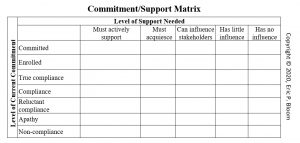Office influence is the ability to move a person’s thinking, actions and/or decisions in a way that forwards your business objectives. This concept holds true regardless of your physical working location.
When working from home, there is still the expectation that business goals, deadlines and deliverables must be achieved. To meet these expectations, you must still have the ability to motivate your team, acquire needed internal resources, coordinate with other organizational silos, and influence them all to move in your needed direction.
While influence-related concepts and principles remain the same, regardless of the communication mechanism, the techniques and tactics to employ them must be modified to maximize their effectiveness in a virtual world.
Below are five influence techniques designed for a virtual world, but will work equally as well when/if you return to the office.
1. Forward quality whitepapers and blogs to your coworkers
When you receive marketing emails containing high quality whitepapers or relevant high-quality blog links that are not relevant to you personally, before deleting them, take a moment and consider what coworkers would find them of value. Then send it to them with a simple message saying, “I saw this and thought of you.”
This simple act has multiple advantages:
- It builds a feeling of reciprocity in them toward you, potentially causing them to do something nice for you in the future.
- It shows your thought leadership by illustrating your willingness to share your knowledge with others
- It helps make the person like you more, which makes it easier for you to influence them in the future
- It enhances your professional brand by showing that you’re well read and want to be a good team player
2. Taking logistical control
Virtual meetings and other virtual business activities require specific logistics, such as emailing needed documents, designing and emailing an agenda, and writing and emailing minutes. Making the leadership/proactive decision to take control of these, and other related items, has many influence-related advantages, including:
- Over time as a team’s culture solidifies, the team members fall into roles regarding how they act, what they do, who leads and who follows. This is also true to a lesser degree for impromptu meetings. If you take control of the meeting’s logistics, it positions you to take control of the discussions and decisions made during the meeting.
- By taking care of the logistics, it builds a small feeling of obligation and thanks (reciprocity) in others toward you.
- The meeting minutes, which are the permanent record of what was said, are written from your point of view.
- Because you have taken the action items of setting up the meeting and writing the minutes, it’s unlikely that you will get other action items you don’t want.
3. Be a communication gateway
When everyone is working in a virtual environment, interpersonal communication tends to be via email, formal meetings, collaborative software, such as Microsoft Teams and Slack, and one-on-one conversations. What’s missed is hallway conversation, learning though osmosis because of your proximity to others, and impromptu meetings on a specific topic.
This technique suggests acting virtually as you would in the office.
- Call people to tell them about important decisions and conservations
- Conference additional people into important one-on-one phone calls
- Send FYI emails to individual coworkers, to let them know you thought about them
4. Use video
Video is becoming more and more popular, but there is still a large percentage of people who feel uncomfortable use it. Embrace video. When on a virtual meeting, it gives you an immediate advantage over those with no video. It’s the in-office equivalent of having five people physically in a conference room and two people on the speaker phone and everyone in the room forgets they’re on the call.
A second way you can use video to your advantage is to schedule video calls with coworkers you have never met in person. A ten- or fifteen-minute video call will make them more familiar with you, thus enhancing their trust in you, which increases your ability to influence them.
5. Small show of gratitude
Like most, as a child I was taught to always say “please” and “thank you”. As adults, however, it’s often overlooked. My suggestion is to remember to say “please” because it’s a show of respect and say “thank you” because it’s a show of gratitude.
While sending an email with the words “thank you” is nice, it’s not memorable. It creates a quick smile and is then deleted and forgotten. Go beyond a simple acknowledgement and do something more memorable, like the following:
- Buy a book on amazon they mentioned they wanted to read and have it delivered to their office or home
- If they agreed to fit you into their business work schedule by meeting with you at lunch time, have a pizza delivered from their local Domino’s pizza place.
- Email them a more detailed thank you email about the value they provided and copy their boss
Thank you gestures such as these are personalized, rememberable, and just plain nice. The influence advantage of this techniques is that they will be more likely to assist you the next time you ask for help.
In closing
If you look holistically at the advice in this blog you will see a common theme, be nice to people and do good things. These techniques and others like them won’t always enhance your professional advantage. At worst, you’ve gotten to know your coworkers a little better, a coworker/friend feels like they owe you a favor because you bought them a pizza, and/or your coworkers are a little bit more knowledgeable because of your actions. At its best, it will help you expand your office influence, enhance your professional brand, and make the virtual world a nicer place.





